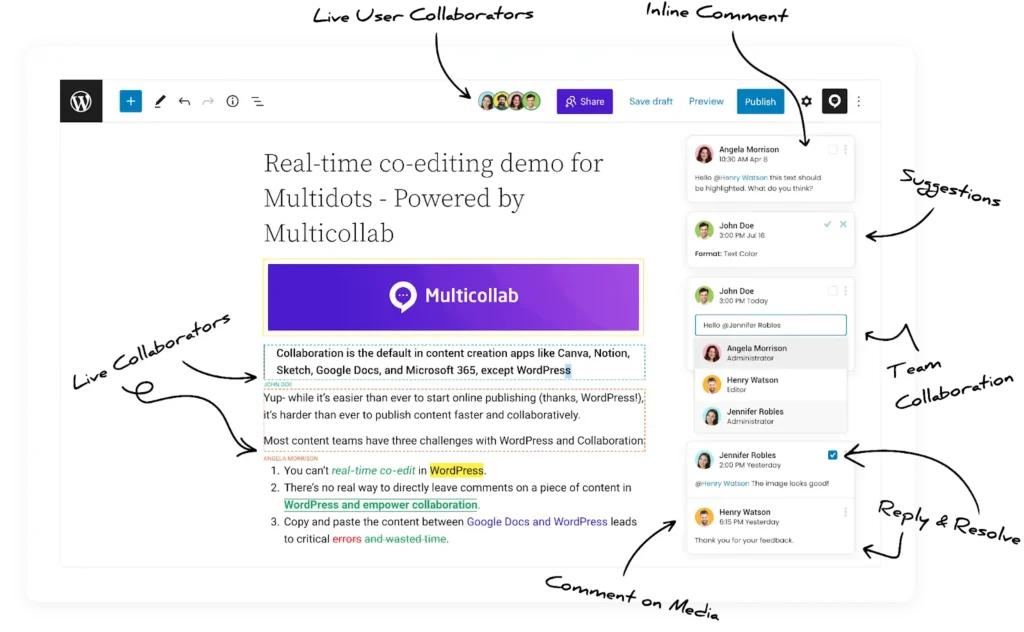Table of Contents
Ever wonder what makes high-performing teams truly stand out? It’s not just talent or tools – it’s the way they communicate and grow together. At the heart of this is collaborative feedback, a simple yet powerful process that helps teams transform ideas into action and deliver their best work.
When done right, feedback does so much more than point out what’s working and what’s not. It builds trust, encourages open communication, and drives continuous improvement. A structured feedback process can boost productivity, elevate the quality of your content, and help your team grow stronger with every project.
In this guide, we’ll show you how to harness the power of collaborative feedback to unlock your team’s potential. You’ll learn actionable strategies to create a feedback-friendly culture, along with tips on using tools like Multicollab to simplify and streamline the process within WordPress. Let’s get started.
Understanding collaborative feedback in a team context
Collaborative feedback is all about teamwork. It’s not just one person presenting their opinions; it’s a back-and-forth process where everyone actively gives and receives input. This dynamic approach helps teams grow together, refine their work, and build a culture where improvement is constant. It’s about creating a safe space for ideas to flourish and ensuring everyone feels heard and valued.
Why does collaborative feedback matter?
- Open feedback creates clarity. It helps team members talk things through, address concerns, and stay on the same page.
- Feedback offers learning moments. Team members gain insights into what they’re doing well and where they can level up.
- When feedback is part of the workflow, individual contributions naturally align with the team’s bigger goals, keeping everyone moving in the same direction.
Ultimately, collaborative feedback isn’t about pointing out problems—it’s about working together to find solutions and celebrate wins.

Types of feedback in team settings
Feedback doesn’t have to be one-size-fits-all. Different situations call for different approaches:
Real-time vs. scheduled feedback sessions
- Real-time feedback: Think of this as on-the-spot input. Whether you’re brainstorming ideas or wrapping up a meeting, real-time feedback keeps momentum high and helps solve problems before they grow.
- Scheduled feedback: This is more structured—like a weekly check-in or a project review. It’s a chance to reflect, go deeper, and plan ahead in a more focused setting.
Constructive vs. Appreciative feedback
- Constructive feedback: This is the “how to improve” kind. It’s about offering clear, actionable suggestions without discouraging the recipient.
- Appreciative feedback: A form of recognition; highlights what’s going well, celebrating wins and reinforcing positive behaviors.
The key is finding the right mix of these feedback types to keep your team motivated and moving forward.
Building a foundation for a feedback-driven culture
Feedback only works when people feel safe enough to share it. If team members are afraid of judgment or criticism, they’ll hold back. And that’s a missed opportunity. Here’s how to establish psychological safety within your team:
- Show your team it’s okay to make mistakes by being open about your own. Vulnerability from leaders sets the tone for everyone else.
- Make it clear that feedback is about helping each other succeed, not tearing anyone down.
- Celebrate progress and learning, even when things don’t go perfectly. This reinforces the idea that trying is just as important as succeeding.
Setting clear objectives for feedback
Clear objectives make feedback purposeful and effective. When everyone knows the “why,” it’s easier to focus on what matters—whether it’s refining messaging, improving collaboration, or helping team members grow in specific skills. Purpose-driven feedback elevates the final product and avoids unnecessary nitpicking, keeping the process constructive and meaningful.
Establishing team norms for feedback
Feedback works best when expectations are clear. Set team norms that encourage open, respectful communication. Make sure everyone feels their feedback, ideas, suggestions, or concerns are welcome and valued.
While constructive criticism is important, the tone matters. Encourage your team to keep feedback respectful and focused on solutions. Integrate feedback into your regular workflow so it becomes a natural, routine part of the process rather than something to avoid.
Encouraging a growth mindset
A growth mindset is essential for fostering a feedback-driven culture. It encourages teams to see mistakes as opportunities for learning rather than setbacks. By celebrating risks and stepping out of comfort zones, regardless of the outcome, teams can embrace continuous improvement. Feedback should be viewed as a tool for uncovering potential and driving progress, not as a measure of failure.
Best practices for effective collaborative feedback
Be specific and actionable: Vague feedback causes confusion. Instead of saying, “This needs work,” be clear about what to improve and how. For example, “Let’s refine the headline to focus more on the customer’s pain point.” This gives your team a clear path forward.
Balance positive and constructive feedback: Start with what’s working well, then address areas for improvement. For example, “Your introduction is engaging—let’s bring that same energy to the conclusion.” This balance boosts motivation and growth.
Encourage two-way feedback: Feedback should go both ways. Create opportunities for team members to share their perspectives, whether on your feedback or the project itself. Tools like Multicollab make this easy with inline comments and suggestions.
Regular check-ins and reviews: Feedback isn’t a one-time event. Schedule regular check-ins to track progress, clarify goals, and keep the team aligned. This ensures ongoing improvement and accountability.
Leveraging Multicollab for streamlined collaborative feedback in WordPress
Imagine a team working on a blog post. The editor uses inline comments to highlight areas for improvement, such as clarifying a headline or refining a paragraph. The writer reviews these comments and uses suggestion mode to test alternative phrasing without disrupting the original content. The team collaborates in real-time, finalizing edits efficiently and with complete clarity.

Multicollab is a powerful collaboration plugin designed to simplify feedback workflows for WordPress teams. By integrating real-time collaboration features directly into WordPress, Multicollab ensures that feedback is seamless, organized, and actionable, helping teams produce high-quality content faster.
Inline comments: Team members can leave comments directly within the content, tying feedback to specific text or sections. This precision eliminates confusion and ensures that actionable insights are always clear.
Suggestion mode: Editors can suggest changes without altering the original content, allowing authors to review and accept updates easily, ensuring accountability and clarity.
Real-time collaboration: Team members can work together simultaneously in WordPress, enabling instant feedback and faster turnaround times.
Slack notifications: Teams can stay updated with feedback alerts directly in their Slack workspace, ensuring no comment or suggestion is overlooked.
Custom permissions: Team managers can assign roles and control access to feedback, ensuring the right stakeholders are involved while maintaining content security.
Version tracking: Teams can access a complete history of feedback and revisions, providing valuable context and reducing backtracking in editorial workflows.
Multilingual support: It is easy to collaborate across global teams by enabling feedback and revisions in multiple languages.
Multicollab turns WordPress into a collaborative hub, transforming feedback into a streamlined, productive process.
Measuring the impact of collaborative feedback on team performance
By tracking key metrics, teams can gauge the effectiveness of their feedback processes.
Tracking key performance indicators (KPIs)
Set KPIs like revision turnaround time, content quality scores, and team engagement levels. Tools like Google Analytics for content performance or Asana for task completion times can help you measure improvements in these areas. Faster revisions and more active participation in feedback sessions are signs of an effective system.
Monitoring content quality improvements
Consistent feedback helps enhance content quality by minimizing errors and aligning it with brand guidelines. Tools like Grammarly or Hemingway Editor can help assess readability scores, while tracking post-publication changes in tools like WordPress can show a reduction in edits.
Assessing team productivity
Efficient feedback loops speed up content production. Tools like Trello or Monday.com can help teams track progress, showing how faster feedback translates to quicker approval times and higher overall throughput.
Addressing common challenges in collaborative feedback
Collaborative feedback can transform team performance, but it’s not without challenges. Here’s how to tackle common obstacles effectively:
Feedback overload: Too much feedback can overwhelm teams and dilute focus. To manage this, prioritize feedback based on its impact on the project. Use Multicollab’s inline comments to keep feedback concise and tied to specific content areas, reducing unnecessary back-and-forth.
Balancing feedback with existing workflows: Integrating feedback sessions into daily operations can be tricky. Schedule regular but brief sessions and leverage Multicollab’s real-time collaboration to minimize disruption. Features like Slack notifications ensure that team members stay updated without interrupting their workflow.
Ensuring feedback is constructive: Efficient feedback loops speed up content production. Tools like Trello or Monday.com can help teams track progress, showing how faster feedback translates to quicker approval times and higher overall throughput.
Final thoughts
Collaborative feedback is a powerful tool for fostering team growth, improving productivity, and delivering high-quality content. By adopting a structured approach to feedback, teams can align better, learn continuously, and achieve their goals more effectively.
Don’t wait. To streamline this process, leverage Multicollab’s powerful features within WordPress today.
Remember, refining feedback processes is an ongoing journey. As your team evolves, so will its needs—embrace this growth to unlock new levels of success in your content and collaboration efforts.







